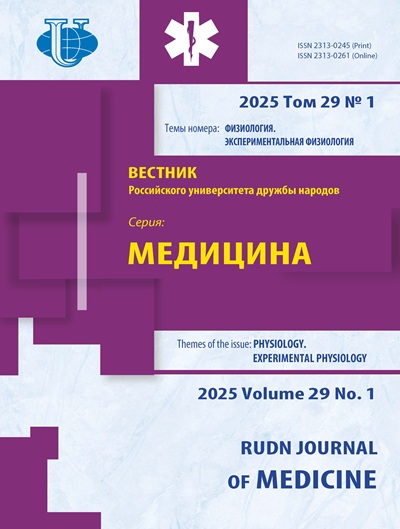RUDN Journal of Medicine
EDITOR IN CHIEF
Zhanna D. KOBALAVA, Corresponding Member of the Russian Academy of Sciences, MD, Professor, Head of the Department of Internal Medicine with a course of cardiology and functional diagnostics named after V.S. Moiseev, Medical Institute, RUDN University, Moscow, Russia;
ISSN: 2313-0245 (Print) ISSN: 2313-0261 (online)
Founded in 1997. Publication frequency: quarterly.
Open Access: Open Access![]() . APC: no article processing charge
. APC: no article processing charge
Peer-Review: double blind. Publication language: Russian, English
PUBLISHER: Peoples’ Friendship University of Russia named after Patrice Lumumba (RUDN University)
Indexation: Russian Index of Science Citation, Google Scholar, Ulrich's Periodicals Directory, WorldCat, East View, Dimensions, DOAJ, Lens, Research4Life, ResearchBib, JournalTOCs, British Library, Bodleian Libraries (University of Oxford), Ghent University Library
DEPUTY EDITORS-IN-CHIEF
Timur Kh. FATKHUDINOV, MD, Professor, Avtsyn Research Institute of Human Morphology of Federal state budgetary scientific institution "Petrovsky National Research Centre of Surgery", Moscow, Russia
Svetlana V. GURYANOVA, PhD, Associate Professor, Shemyakin and Ovchinnikov Institute of Bioorganic Chemistry, Russian Academy of Sciences, Moscow, Russia.
The “RUDN JOURNAL OF MEDICINE” is a quarterly journal that publishes peer-reviewed medical research papers since 1997. A major goal of the journal is to integrate the results of fundamental and clinical research and rich experience of Russian and foreign experts in the field of clinical medicine, biomedical problems and global health.
The mission of the journal is to integrate the results of scientific work of scientists and the rich clinical experience of specialists into the international scientific space, to be an international scientific platform for doctors and scientists, to discuss and exchange experience in the field of healthcare, as well as to raise the level of scientific research and develop international scientific cooperation.
Aims and Scope. The Journal is aimed at cooperation and scientific exchange in the field of biomedicine, publication of the results of fundamental and applied researches of Russian and foreign scientists. Primary areas covered range from oncology, physiology and neurobiology, allergology and immunology, to medical genetics and microbiology, as well as infectious diseases. Each issue is devoted to a specific medical topic that is announced in advance. The invited editors of the issues are both Russian and foreign scientists.
We accept original research including reviews, important new tools and techniques, and clinical cases. Papers may be submitted in Russian and/or English. Authors must ensure that the article was not published elsewhere before, either as a whole or in part, in Russian or other languages. They should also guarantee that the paper submitted is not under consideration in other scientific journals. The journal is intended for researchers, lecturers, graduate students and young scientists, practitioners who do research to develop new and improve existing preventive, diagnostic, therapeutic and rehabilitation methods. The Editorial Board of the journal encourages individual researches and research teams to collaborate in preparing issues devoted to specific topics: http://journals.rudn.ru/medicine/announcement/view/327
The journal strictly adheres to the international standards of publication ethics formulated in the COPE document (Committee on Publication Ethics) http://publicationethics.org
Articles are accepted for publication provided that the requirements for the design of manuscripts are met, the procedure for internal examination and external double-blind peer review is successfully passed, the material complies with international standards of publication ethics, and the requirements for the design of bibliographic references are met. The journal does not guarantee acceptance of an article for publication or a very short review period.
When preparing a manuscript for submission, as an example of design, you should pay attention to the articles from the current issue.
Contact e-mail: medj@rudn.ru
Announcements
The journal is included in the database ScopusPosted: 05.09.2023
RUDN Journal of Medicine is included in the Scopus database in July 2023. Publications of 2019-2023 issues are indexed. |
| More Announcements... |













